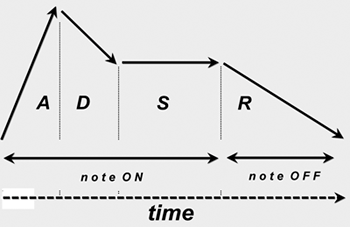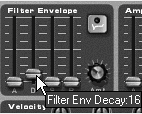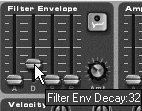| The SubTractor's amp envelope and filter envelope faders regulate how the tones behave over time. Instead of playing steady tones, the envelopes allow the oscillators to mimic many of the sound variations of real-life instrumentssuch as louds and softs, and bright and dark tonal variations. The primary envelope is the amp envelope, which varies louds and softs (amplitude) from the time a note is struck until it gets released. Each time a note is played, the amp envelope opens and closes a gate in four stages: attack, decay, sustain, and releasecommonly referred to as ADSR (Figure 5.33). Figure 5.33. An ADSR envelope 
Amp envelope Let's start with the attack and release faders. Attack (A) is how quickly a sound ramps up to maximum level, and release (R) is how long a note takes to fade out after it is released. By adjusting these amp envelope faders, you can play notes with sharp attacks that fade out quickly, play sustained sounds that keep sounding long after you take your finger off the key, or make your own volume shapes. To adjust amp envelope attack and release 1. | Load your test patch and start your loop.
| 2. | Push up the A fader. This engages a quick fade at the beginning of each note in your bass line.
| 3. | Now nudge the R fader up just a bit, and the notes begin to fade out slowly (Figure 5.34).
Figure 5.34. The amp envelope's attack and release faders control how your notes begin and end. 
| 4. | Nudge R farther up, and the notes begin to run together.
| 5. | Nudge R all the way up, and the notes bleed into one another from one loop repetition to the next (until your eight-note polyphony runs out).
|
 Tips Tips
You can't do a long fade-in on a short note! Setting the attack stage too high on short notes will simply mute the sound, because the note will end before the ramp reaches an audible level. To eliminate overlapping, just set your SubTractor's Polyphony counter to 1.
The amp envelope decay (D) fader controls how long it takes for the sound to drop in volume from its attack peak to the sustain stage. The sustain (S) fader sets the volume for the main body of the sound. Sustain length is determined by the note duration in the Sequencer track. To adjust amp envelope decay and sustain 1. | Load your test patch and set the S and the D faders all the way down.
| 2. | Play your loop and move the D fader up and down until the notes become shorter overall.
With sustain off, the attack becomes the only part of the note you hear.
| 3. | To lengthen the notes again, move the S fader up and down. At this point, it may sound as if the D and S faders both do the same thing.
| 4. | To hear the difference, first lower both the D and S faders all the way down. The bass notes become short clicks (no duration).
| 5. | Now bring up the D fader slightly, listening to how the notes sound as the decay becomes audible.
The decay fader never changes volume, only how fast a note fades from attack to sustain.
| 6. | Lower the D fader to 0 again and nudge up the S fader.
With the decay stage off, a sudden drop in volume occurs between the attack and the sustain stages, resulting in a click. Get rid of this by boosting the D fader again.
|
Filter envelope The filter envelope's ADSR faders work like those of the amp envelope, but the filter envelope increases and decreases brightness instead of volume. It moves the frequency fader up and down as an offset to your Filter 1 and 2 settings. The filter envelope depends on the amp envelope for sound. If the amp envelope R fader is at 0, the filter envelope's R fader won't do anything. That's why, in order to test the filter envelope, you need to adjust the amp envelope faders to "neutral" positions first. To set the amp envelope to neutral 1. | Move the A fader down to 0.
| 2. | Move the D and S faders to 100.
| 3. | Move the R fader to 73 (Figure 5.35).
Figure 5.35. The amp envelope, set to "neutral" 
Your bass notes will now play their full sound and duration (sixteenth notes) through the release stage.
|
Now you're ready to work the filter envelope. To adjust the filter envelope attack 1. | With your bass loop playing, activate the filter envelope by turning the Amt knob to the right to about 40 (Figure 5.36).
Figure 5.36. Turn up the filter envelope Amt knob to activate it. 
The Amt knob only affects how far up and down the filter frequency is going to travel. (Turning it up won't lengthen your stages.)
| 2. | Now slowly nudge the filter envelope A fader upward. The attack effect differs at various values:
At about 28, the click disappears and the brightness attack ramp sounds like a synth brass attack.
At about 42, the note attack sounds "bubbly."
At about 50, the note is starting to sound "backwards."
Past 66, the attack ramp is longer than the note, and the filter never kicks in at all.
|
To adjust the filter envelope decay 1. | With your loop playing, drag the filter envelope's A fader down to 0, and the D fader just above the point where it causes a "pop," around 16 (Figure 5.37).
Figure 5.37. At a low decay fader setting, you'll hear a "pop." 
Hear how the envelope decay creates a short bright period in each note that quickly dissipates into the darker sustained tones you started with.
| 2. | Drag the D fader to 32 to lengthen the bright period into a solid pulse (Figure 5.38).
Figure 5.38. A longer decay causes a bright pulse. 
Assuming you're adjusting tone on relatively short (sixteenth) notes, the decay length will probably max out at 55, and the dark sustained tone you started with will drop out (Figure 5.39).
Figure 5.39. When decay is longer than note length, the fader has little effect. 
|
To adjust filter envelope sustain 1. | With your loop playing, drag the filter envelope's D fader back to 0.
| 2. | Now slowly raise the S fader.
Filter envelope sustain works differently from amp envelope sustain: Instead of setting a volume, filter envelope sustain sets a filter frequency for the filter to rest at throughout the sustain stage of the sound. The sustain period length is still determined by holding down a key or by the note length in the Sequencer.
|
 Tips Tips
The R fader is not applicable with short-note-value bass lines. Why? The filter envelope release stage resets to the attack stage whenever a new note is pressed. Filter release will therefore only work when the amp envelope release is set high and there is enough space between notes for filter release to "trail" behind the note. The filter envelope has an Invert Filter button (Figure 5.40) that will invert the filter setting. When Invert Filter is enabled, the attack stage of the filter envelope will ramp down in brightness instead of up. With all the variables at work, the best way to use this feature is to simply press the button and hear what happens! Figure 5.40. The Invert Filter button 
|


 Tips
Tips




